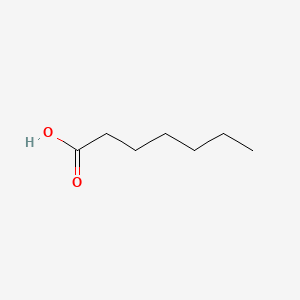| MeSH term | MeSH ID | Detail |
|---|---|---|
| Olfaction Disorders | D000857 | 17 associated lipids |
| Byssinosis | D002095 | 11 associated lipids |
| Mitochondrial Diseases | D028361 | 25 associated lipids |
HEPTANOIC ACID
HEPTANOIC ACID is a lipid of Fatty Acyls (FA) class. Heptanoic acid is associated with abnormalities such as Dehydration. The involved functions are known as Process, Anabolism, inhibitors, Oxidation and fatty acid oxidation. The related lipids are Heptanoates and undecanoic acid.
Cross Reference
Introduction
To understand associated biological information of HEPTANOIC ACID, we collected biological information of abnormalities, associated pathways, cellular/molecular locations, biological functions, related genes/proteins, lipids and common seen animal/experimental models with organized paragraphs from literatures.
What diseases are associated with HEPTANOIC ACID?
HEPTANOIC ACID is suspected in Dehydration and other diseases in descending order of the highest number of associated sentences.
Related references are mostly published in these journals:
| Disease | Cross reference | Weighted score | Related literature |
|---|
Possible diseases from mapped MeSH terms on references
We collected disease MeSH terms mapped to the references associated with HEPTANOIC ACID
PubChem Associated disorders and diseases
What pathways are associated with HEPTANOIC ACID
There are no associated biomedical information in the current reference collection.
PubChem Biomolecular Interactions and Pathways
Link to PubChem Biomolecular Interactions and PathwaysWhat cellular locations are associated with HEPTANOIC ACID?
There are no associated biomedical information in the current reference collection.
What functions are associated with HEPTANOIC ACID?
Related references are published most in these journals:
| Function | Cross reference | Weighted score | Related literatures |
|---|
What lipids are associated with HEPTANOIC ACID?
Related references are published most in these journals:
| Lipid concept | Cross reference | Weighted score | Related literatures |
|---|
What genes are associated with HEPTANOIC ACID?
There are no associated biomedical information in the current reference collection.
What common seen animal models are associated with HEPTANOIC ACID?
There are no associated biomedical information in the current reference collection.
NCBI Entrez Crosslinks
All references with HEPTANOIC ACID
Download all related citations| Authors | Title | Published | Journal | PubMed Link |
|---|---|---|---|---|
| Coviello AD et al. | Intratesticular testosterone concentrations comparable with serum levels are not sufficient to maintain normal sperm production in men receiving a hormonal contraceptive regimen. | 2004 Nov-Dec | J. Androl. | pmid:15477366 |
| De Lisi R et al. | Heat capacity of transfer of (Ethylene oxide)13-(propylene oxide)30-(ethylene oxide)13 from water to the aqueous anionic surfactant solutions at 298 K. A quantitative treatment. | 2004 | Langmuir | pmid:15518478 |
| Schubert M et al. | Intramuscular testosterone undecanoate: pharmacokinetic aspects of a novel testosterone formulation during long-term treatment of men with hypogonadism. | 2004 | J. Clin. Endocrinol. Metab. | pmid:15531493 |
| Taogoshi T et al. | Transport of prostaglandin E1 across the blood-brain barrier in rats. | 2005 | J. Pharm. Pharmacol. | pmid:15638994 |
| Gyarfas BJ et al. | Supramolecular structures of coronene and alkane acids at the Au(111)-solution interface: a scanning tunneling microscopy study. | 2005 | Langmuir | pmid:15667168 |
| Cherrier MM et al. | The role of aromatization in testosterone supplementation: effects on cognition in older men. | 2005 | Neurology | pmid:15668427 |
| David A et al. | Depot fluphenazine decanoate and enanthate for schizophrenia. | 2005 | Cochrane Database Syst Rev | pmid:15674872 |
| Nishi Y et al. | Ingested medium-chain fatty acids are directly utilized for the acyl modification of ghrelin. | 2005 | Endocrinology | pmid:15677766 |
| Amory JK and Bremner WJ | Oral testosterone in oil plus dutasteride in men: a pharmacokinetic study. | 2005 | J. Clin. Endocrinol. Metab. | pmid:15713724 |
| Coviello AD et al. | Low-dose human chorionic gonadotropin maintains intratesticular testosterone in normal men with testosterone-induced gonadotropin suppression. | 2005 | J. Clin. Endocrinol. Metab. | pmid:15713727 |
